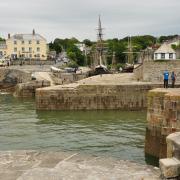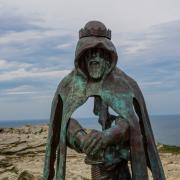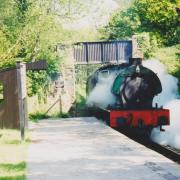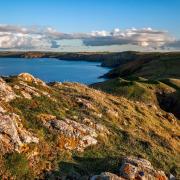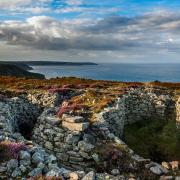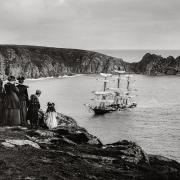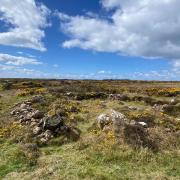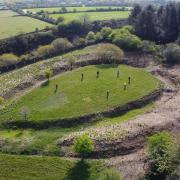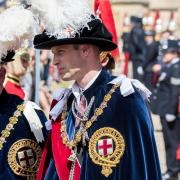Cornwall is home to ancient circles and mysterious monoliths dating back thousands of years - award-winning photographer David Chapman goes in search of their stories
A stone circle is simply a set of standing stones arranged in a circle, they occur across Europe with many found in Britain, especially the more remote northern and western counties. In Cornwall we have more than our fair share with some wonderful circles in great locations.
Most stone circles, including those in Cornwall, were constructed in the late Stone Age or early Bronze Age, about four or five thousand years ago but to find the origin of these circles we have to look beyond our county. Recent research has shown that the earliest example in the UK was probably on the Orkney Isles. Radiocarbon dating of bones found in the ditch around the Stones of Stenness Circle, on Mainland Orkney, shows it to have been constructed around 5400 years ago. This pre-dates the nearby Ring of Brodgar and, more significantly, the best-known of all stone circles at Stonehenge in Wiltshire which is probably similar in date to most of the stone circles found in Cornwall.

The purpose of stone circles remains a mystery though this attracts a great deal of speculation. Analysis of many suggests an alignment with the stars, moon or sun at various times of the year. Out-lying stones, often forming straight lines towards the circles might indicate ancient pathways, some would argue that they tie in with energy, or ley, lines. Many stone circles have been extensively dowsed to find such links.
Few stone circles contain evidence of habitation or burials, so this would indicate that their use was limited to occasional visits, it is often suggested that they were places of ceremony or ritual, though I often think this is archaeologist-speak for ‘we haven’t got a clue!’. Personally, I feel that our lack of understanding adds to their aura, without which they wouldn’t have as many wonderful myths and legends, some of which I explore here.
Seven of the best
It is the remoteness of Cornwall which has allowed us to keep so many of our stone circles. Without doubt there would once have been many more but the impact of the plough and the pilfering of stones for wall and house building has had an impact. We need to look to the more remote and least ploughed parts of the county to find the best stone circles.
The Merry Maidens
This is likely to be one of the best-preserved stone circles in Britain. It is thought that most or all of the stones are original and only a small number have been re-erected. The nineteen stones, all between one and one and a half metres tall, are evenly placed (with a slightly wider gap as an entrance) in a large circle of about twenty-four metres diameter and there are a few extra stones sunk into the ground which might have formed part of a pathway to the site. In adjacent fields there are two standing stones known as The Pipers which would appear to have been constructed in association with the circle and have since been named to tie in with its legend.
It is said that the stones are the remains of nineteen maidens who were turned to stone as a punishment for dancing on the Sabbath. The two pipers who were playing the music for their dancing heard the church clock strike midnight and realising they were breaking the rule decided to run away, but they were too late. They too were turned to stone and this is why their stones are so far away from the maidens. The Merry Maidens can be found on the south side of the B3315 just west of Lamorna.

Boscawen-un
The stone circle of Boscawen-Un also has nineteen stones but this circle is made all the more impressive by having a large standing stone within it. This towering stone is about three metres long but because it stands at an angle is only about two metres tall. Low down on this central stone is an axe-head carving making this quite unusual.
The stones are of a similar height and the circle (slightly elliptical) a similar diameter to that of the Merry Maidens and there is also a wider gap at one point in the circle which might have acted as an entrance. Its situation, within an enclosure surrounded by Cornish hedges is not how it would have looked originally. The hedges were built in the 19th century and the stones have been re-erected, but there is no doubting the authenticity of the site and the atmosphere of the location.
The unusual name of this stone circle derives from the Cornish for a farm (bos), an elder tree (scawen) and a pasture (un). Boscawen-Un can be found to the south of the A30 about a mile to the east of Crows-an-wra.

Nine Maidens Circle (Boskednan)
This stone circle would once have been very impressive standing, as it does, on the high moorland of West Penwith. It is thought that it might originally have been a large circle with a diameter of about twenty-two metres and might have consisted of twenty-two stones, but only a handful of these stones remain in situ and even fewer are still standing.
The largest of the stones stand up to two metres tall and are positioned on the side of the circle facing Carn Galver, the most distinctively shaped of all the hills of the West Penwith moors and presumably held in some esteem by the builders of this circle.

Men-an-Tol
Mên-an-Tol literally means ‘holed stone’, a reference to the large central stone at this monument. In its current state Mên-an-Tol doesn’t appear to be a stone circle, being simply an arrangement of one holed stone with a standing stone to either side, but it is thought that this was originally the site of a stone circle with the holed stone at its centre.
Legend has it that clambering through the holed stone, also known as the Crick Stone, could cure a child of rickets among many other ailments, and given its obviously symbolic shape it should come as no surprise to learn that it could also improve your fertility. Generally it is regarded as important to pass through it in a certain direction and a specific number of times, usually three, seven or nine.
Mên-an-Tol and Nine Maidens can be found by parking in the lay-by at Bosullow on the road between Madron and Morvah. From here take the track to the north-west where it is possible to do an attractive circular walk encompassing Mên-an-Tol, Ding Dong mine and Nine Maidens stone circle.

Treheseal
Tregeseal East stone circle lies just to the south of the dramatic hilltop of Carn Kenidjack. Like many of the other stone circles of the area it comprises of nineteen standing stones but it is likely that many of these stones have been moved or at least re-erected. There may have been three stone circles in this area making this a once significant site and there are many stories linking this stone circle to Cornish piskeys, fairies and the devil himself.
Tregeseal is a village just to the north of St Just (in Penwith), from the village take the minor road to the east and continue on the footpath through Hailglower Farm.

Duloe Stone Circle
Duloe is interesting for a few reasons, not least the fact that it is in a part of the county which is under-represented by stone circles, probably due to the prevalence of agriculture through the centuries. One other reason which makes it rather unusual is that the stones are not granite, they are quartzite, and they are very large with the biggest being about two and a half metres tall weighing in at an estimated 12 tons.
In its current state the circle is actually an ellipse but we know that some of the stones were moved when a hedge, which had been built through the middle of it, was removed in the 19th century. At the same time the largest of the stones was broken in two and the circle was re-made as it now stands, with a relatively small diameter of twelve metres. Within the circle a funeral urn was discovered implying that someone of importance was buried here. Duloe stone circle can be found by taking the footpath to the east from the B3254 just north of the church.

The Hurlers Stone Circle
This is the most compelling of all the stone circle remnants found on Bodmin Moor. Within my selection of circles The Hurlers is unique in having three stone circles at the same site, though one of them has only a couple of stones in the vertical position. The northern circle once had thirty stones, approximately half of these remain visible; the middle circle has fourteen stones and fourteen markers indicating a total of twenty-eight in total.
Interestingly the legend of The Hurlers makes reference to men, rather than women. They were playing a game of Cornish Hurling on the Sabbath and were turned to stone as punishment. As with the stones at The Merry Maidens, they also had a couple of pipers providing musical accompaniment and they were also turned to stone. The Pipers are the two standing stones to the west of the circles.
To access The Hurlers, park in the car park at the south-west side of Minions village and head north west onto the moor for a short distance, but if you go on a Sunday don’t sing, dance or play games!

Photography tips
Stone circles can be quite difficult to photograph because, from ground level, they are very wide and not very tall so they don’t fit well into the standard format, here are some tips to help:
Try using the panorama format in your camera (most phones have this setting);
Photograph stone circles when there is an interesting sky, this will help fill the frame;
If you have a drone try that (with necessary permissions), unfortunately I don’t have one so to get extra height I lift my camera up on top of a monopod, high above my head; one alternative is to take a pair of step ladders (don’t laugh, it has been known!) or stand on a suitable hedge;
Take photos early or late in the day when the sun is low in the sky to get better shadows;
Get down low to make the standing stones look more impressive;
Try to avoid foreground stones overlapping with stones on the other side of the circle;
Try taking photos at night when you can get a sky full of stars, seems suitable for the subject matter;
If it snows take advantage of the better foreground this offers.
To see more of David’s photography visit his website at www.davidchapman.org.uk or look out for his book ‘Photographing Cornwall’ available in all local bookshops.





